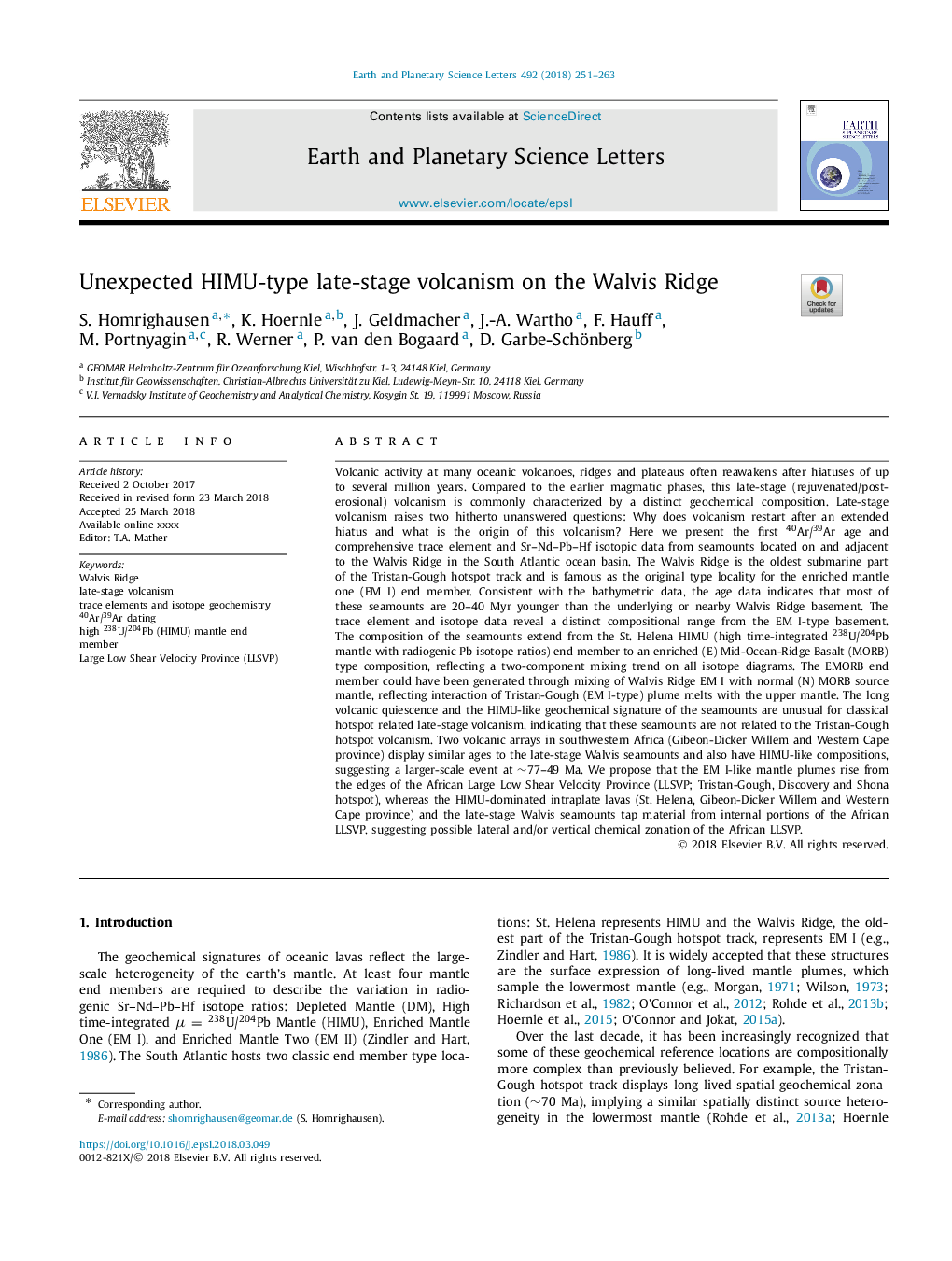| کد مقاله | کد نشریه | سال انتشار | مقاله انگلیسی | نسخه تمام متن |
|---|---|---|---|---|
| 8906922 | 1634664 | 2018 | 13 صفحه PDF | دانلود رایگان |
عنوان انگلیسی مقاله ISI
Unexpected HIMU-type late-stage volcanism on the Walvis Ridge
دانلود مقاله + سفارش ترجمه
دانلود مقاله ISI انگلیسی
رایگان برای ایرانیان
موضوعات مرتبط
مهندسی و علوم پایه
علوم زمین و سیارات
علوم زمین و سیاره ای (عمومی)
پیش نمایش صفحه اول مقاله

چکیده انگلیسی
Volcanic activity at many oceanic volcanoes, ridges and plateaus often reawakens after hiatuses of up to several million years. Compared to the earlier magmatic phases, this late-stage (rejuvenated/post-erosional) volcanism is commonly characterized by a distinct geochemical composition. Late-stage volcanism raises two hitherto unanswered questions: Why does volcanism restart after an extended hiatus and what is the origin of this volcanism? Here we present the first 40Ar/39Ar age and comprehensive trace element and Sr-Nd-Pb-Hf isotopic data from seamounts located on and adjacent to the Walvis Ridge in the South Atlantic ocean basin. The Walvis Ridge is the oldest submarine part of the Tristan-Gough hotspot track and is famous as the original type locality for the enriched mantle one (EM I) end member. Consistent with the bathymetric data, the age data indicates that most of these seamounts are 20-40 Myr younger than the underlying or nearby Walvis Ridge basement. The trace element and isotope data reveal a distinct compositional range from the EM I-type basement. The composition of the seamounts extend from the St. Helena HIMU (high time-integrated 238U/204Pb mantle with radiogenic Pb isotope ratios) end member to an enriched (E) Mid-Ocean-Ridge Basalt (MORB) type composition, reflecting a two-component mixing trend on all isotope diagrams. The EMORB end member could have been generated through mixing of Walvis Ridge EM I with normal (N) MORB source mantle, reflecting interaction of Tristan-Gough (EM I-type) plume melts with the upper mantle. The long volcanic quiescence and the HIMU-like geochemical signature of the seamounts are unusual for classical hotspot related late-stage volcanism, indicating that these seamounts are not related to the Tristan-Gough hotspot volcanism. Two volcanic arrays in southwestern Africa (Gibeon-Dicker Willem and Western Cape province) display similar ages to the late-stage Walvis seamounts and also have HIMU-like compositions, suggesting a larger-scale event at â¼77-49 Ma. We propose that the EM I-like mantle plumes rise from the edges of the African Large Low Shear Velocity Province (LLSVP; Tristan-Gough, Discovery and Shona hotspot), whereas the HIMU-dominated intraplate lavas (St. Helena, Gibeon-Dicker Willem and Western Cape province) and the late-stage Walvis seamounts tap material from internal portions of the African LLSVP, suggesting possible lateral and/or vertical chemical zonation of the African LLSVP.
ناشر
Database: Elsevier - ScienceDirect (ساینس دایرکت)
Journal: Earth and Planetary Science Letters - Volume 492, 15 June 2018, Pages 251-263
Journal: Earth and Planetary Science Letters - Volume 492, 15 June 2018, Pages 251-263
نویسندگان
S. Homrighausen, K. Hoernle, J. Geldmacher, J.-A. Wartho, F. Hauff, M. Portnyagin, R. Werner, P. van den Bogaard, D. Garbe-Schönberg,